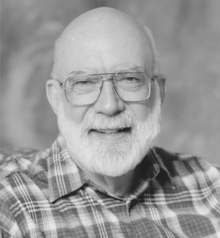Michael Harner
| Michael Harner | |
|---|---|
 | |
| Born | 1929 (age 86–87)[1] |
| Occupation | anthropologist, educator and author |
Michael Harner (born 1929)[1] is an anthropologist, educator and author. He founded The Foundation for Shamanic Studies and the New Age practice of "Core Shamanism." His 1980 book, The Way of the Shaman: A Guide to Power and Healing,[2] has been foundational in the development and popularization of "Core Shamanism" as a path of personal development for new age adherents of neoshamanism.[3]
Career
Michael Harner initially worked in the field of archaeology, including studying the Lower Colorado River area.[4] As a graduate student in 1956-57 he undertook field research on the culture of the Jívaro (Shuar) people of the Ecuadorian Amazon and began to pursue a career as an ethnologist. His dissertation later became the basis for his book, The Jívaro: People of the Sacred Waterfalls.[5]
In 1960-61 he experimented with the Amazonian plant medicine, ayahuasca, which he wrote about in the articles "The Sound of Rushing Water" (1968)[6] and "The Role of Hallucinogenic Plants in European Witchcraft" (1973).[7]
Harner co-chaired the Anthropology Section of the New York Academy of Sciences.[8]
In 1987 Harner left academia to devote himself full-time to his new project, The Foundation for Shamanic Studies. Walsh and Grob note in their book, Higher Wisdom: Eminent Elders Explore the Continuing Impact of Psychedelics, "Michael Harner is widely acknowledged as the world's foremost authority on shamanism and has had an enormous influence on both the academic and lay worlds.... What Yogananda did for Hinduism and D. T. Suzuki did for Zen, Michael Harner has done for shamanism, namely bring the tradition and its richness to Western awareness."[9]
Development of Core Shamanism
After traveling to the Amazon where he ingested the hallucinogen ayahuasca, Harner began experimenting with monotonous drumming. In the early 1970s he started giving training workshops to small groups in Connecticut. In 1979 he founded the Center for Shamanic Studies in Norwalk, Connecticut. In 1980, Harner published The Way of the Shaman: A Guide to Power and Healing.[2] Students in the United States and Europe began to take his classes in what he was now calling "Core Shamanism"[10] (as differenced from traditional, Evenk shamanism, or other indigenous and historical practices that have been referred to as "shamanism" in anthropological texts).
Anthropologist Joan Townsend has distinguished Harner's Core Shamanism from neoshamanism.[11] However, most authors in the field, especially Harner's critics, consider Harner's Core Shamanism to be the primary influence on, and foundation of, the Neoshamanic movement.[3][12][13][14]
Harner later integrated his Center for Shamanic Studies into the non-profit Foundation for Shamanic Studies. The Foundation received financial support primarily from the Core Shamanism courses and workshops he taught, supplemented by private donations. From the early 1980s onward, he invited a few of his students to join an international faculty to reach an ever-wider market. In 1987, Harner resigned his professorship to devote himself full-time to the work of the foundation.[15] He largely ceased publishing, except for occasional articles in the publication, "Shamanism."[16][17]
See also
Bibliography
- Harner, Michael, Cave and Cosmos: Shamanic Encounters with Another Reality (North Atlantic Books 2013)
- Harner, Michael (ed,), Hallucinogens and Shamanism (Oxford University Press 1973)
- Harner, Michael, The Jívaro: People of the Sacred Waterfalls (University of California Press 1972)
- Harner, Michael, The Way of the Shaman (HarperOne 1990) Orig. 1980
- Haviland, William A., Harald E. L. Prins, Bunny McBride and Dana Walrath, "Anthropologist of Note: Michael J. Harner" Cultural Anthropology: The Human Challenge (14th ed.) (Wadsworth 2013)
References
- 1 2 Charles S., Grob; Walsh, Roger. ""My Path in Shamanism"- Interview with Michael Harner". shamanism.org. Albany State University of New York Press. Retrieved 23 April 2015.
- 1 2 Harner, Michael (1980) The Way of the Shaman. San Francisco: Harper & Row. Third edition, 1990. OL 4804365W
- 1 2 Noel, Daniel C. (1997) Soul Of Shamanism: Western Fantasies, Imaginal Realities.Continuum. ISBN 0-8264-1081-2
- ↑ E.g., Kroeber, A.L., and Michael J. Harner. (1955) "Mohave Pottery", Anthropological Records, Berkeley: University of California.
- ↑ Harner, Michael J. (1972) The Jívaro: People of the Sacred Waterfalls. New York: Natural History Press. Second edition 1984, Berkeley and Los Angeles: University of California Press.
- ↑ Harner, Michael J. (1968) "The Sound of Rushing Water." Natural History 77(6).
- ↑ Harner, Michael J., ed. and contributor (1973) Hallucinogens and Shamanism. New York and London: Oxford University Press. OL 5702197M
- ↑ Haviland, William A., Harald E. L. Prins, Bunny McBride and Dana Walrath (2013). Anthropologists of Note: Michael J. Harner. Cultural Anthropology: The Human Challenge (14th ed., p. 307). Belmont: Wadsworth. ISBN 978-1-133-95597-9.
- ↑ Walsh, Roger, and Charles S. Grob, eds. (2005) Higher Wisdom: Eminent Elders Explore the Continuing Impact of Psychedelics, pp. 159, 160. State University of New York Press. Albany.
- ↑ Harner, Michael (2005) "The History and Work of the Foundation for Shamanic Studies," Shamanism 18: 1&2, p. 7.
- ↑ Townsend, Joan B. (2004) "Individualist Religious Movements: Core and Neo-shamanism" Anthropology of Consciousness vol. 15(1), pp. 1-9. doi:10.1525/ac.2004.15.1.1
- ↑ Hobson, G. "The Rise of the White Shaman as a New Version of Cultural Imperialism." in: Hobson, Gary, ed. The Remembered Earth. Albuquerque, NM: Red Earth Press; 1978: 100-108.
- ↑ Aldred, Lisa, "Plastic Shamans and Astroturf Sun Dances: New Age Commercialization of Native American Spirituality" in: The American Indian Quarterly issn.24.3 (2000) pp.329-352. Lincoln: University of Nebraska Press.
- ↑ "White Shamans and Plastic Medicine Men," Terry Macy and Daniel Hart, Native Voices, Indigenous Documentary Film at the University of Washington
- ↑ Harner, Michael (2005) "The History and Work of the Foundation for Shamanic Studies", Shamanism 18: 1&2, p. 5.
- ↑ Harner, Michael, and Sandra Harner (2000) "Core Practices in the Shamanic Treatment of Illness". Shamanism 13 (1&2), pp. 19-30.
- ↑ Harner, Michael (2010) "A Core Shamanic Theory of Dreams". Shamanism 23, pp. 2-4.